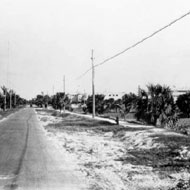In 1911 Collins
started the Miami Beach Improvement Company. He was beginning
to tire of making the 10-mile boat trip across the bay to
bring harvest to market. His vision was to first dredge a
canal through Miami Beach which would allow him to move his
fruits and vegetables to the Bay followed by the construction
of a wooden bridge that would connect Miami Beach to the mainland.
The
Collins Bridge Project was costly. Collins borrowed money
from the Lummus Brother's banks to finance the project, but
at $50,000 per mile, funding for the bridge ran out just a
half a mile short of completion.
In 1913,
Carl
Fisher, a wealthy Midwestern industrialist appeared on
the development scene. Fisher loaned Collins the money to
complete the bridge which opened on June 12th, 1913. At over
two miles in length, the Collins bridge was the longest wooden
bridge in the world.
Fisher also loaned money to the Lummus Brothers to carry out
improvements on the southern end of the island such as draining
the swamps and dredging the bay.
Fisher establishes the third real estate company on the Beach,
the
Alton Beach Reality Company, and acquired the land
between 14th and 19th Streets; linking Lummus to the south
and Collins to the north. Fisher also had a vision for the
island--to create a city existing in an of itself - not as
an adjunct to the established city of Miami across the bay.
Immediately, he draws the plans to build a luxury outdoor
commercial center (Lincoln Mall) and large residential homesites
to lure the wealthier residents to the island.
On March 26, 1915, the leaders of the three land sales companies
consolidate their efforts and incorporate the young community
into the Town of Miami Beach. The following Year the name
was changed to Miami Beach.
At this time 80% of the population lived at the southern end
of the island in the Lummus tracts and there were only thirty-three
registered voters in the community. J.N. Lummus was elected
Mayor and plans were made to supply electricity, telephone,
sewage and water, which at the time was supplied by windmill
powered underground wells.
In 1916 the sale of the land was sluggish. Both Lummus and
Fisher had invested large sums of money in improvements, but
the land sales did not meet their expectations and they were
compelled to create further incentives. Lummus offered free
lots to anyone who promised to build homes on his land.
In 1919 Collins and Fisher became partners to sell real estate
and promote the area. Fisher had a flair for promotion. He
brought in an
elephant
to pose with celebrities for publicity photos. During the
winter months, he bought a billboard on 5th Avenue and 42nd
Street in New Your which flashed "It;s June in Miami".
Fisher's vision began to be realized as wealthy visitors saw
Miami Beach property as solid. He raised the prices of his
lots and increased his marketing efforts. He built the luxurious
Flamingo Hotel to house visitors until they could settle.
Never did he envision a city dominated by large scale hotel
development for transient seasonal population. Significantly
he refused to locate any of his many hotels along prime oceanfront
property.
| Miami
Beach history guide |
|
|














